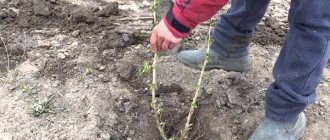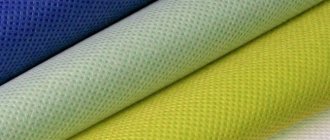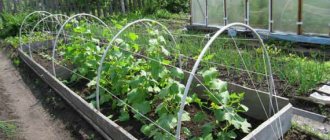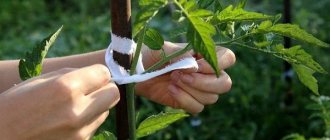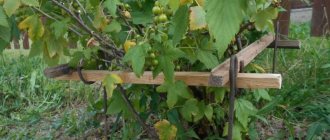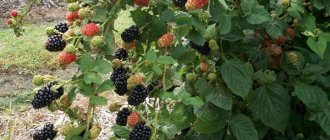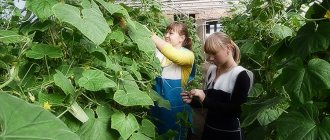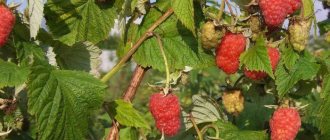To get a good blackberry harvest, it is not enough just to follow the rules of watering and timely fertilizing. A plant with extraordinary growth force (green shoots grow up to 10 cm in a day) must be formed correctly: remove unnecessary branches in time and fix the remaining ones on stable supports. Trellis come to the aid of gardeners, which can not only increase productivity, but also make it easier to care for the crop.
How to make a blackberry trellis with your own hands
There are a large number of blackberry trellises on sale of varying complexity and cost. For several bushes in a summer cottage, the simplest structure is easy to make yourself.
You will need poles (wooden or metal) 2.5...3.0 m long and steel wire 2.0-3.0 mm. in diameter.
- The pillars are installed using a hole drill in holes at least 50 cm deep. There should be a distance of no more than 5-6 m between the supports.
- The free space in the pit is filled with broken bricks or gravel to prevent the post from shrinking;
- The posts are placed in the holes and leveled. If wooden posts are used, then their lower part, which will be located in the ground, is coated with bitumen mastic. The earth around the supports is well compacted and concreted for reliability. Concreting complicates the dismantling of the structure, so it is used in cases where there is confidence that blackberries are planted for a long time and will not be transferred anywhere for at least the next few years.
- 3 rows of wire are stretched (in extreme cases, twine), the distance between the rows is 60 cm. They start pulling the wire from the top so that the top row is located as high as possible.
For even greater reliability, the outer pillars can be secured with guy wires. This simple design is quite suitable for growing any variety of blackberry.
Types of supports
For industrial cultivation of blackberries, trellises are a mandatory part. Without them, brambles (a plant with straight branches growing strongly upward) and dewberry (which has shoots creeping along the ground) will simply be unsuitable for cultivation. Everything is mixed into one big lump that is difficult to untangle and the berries will either rot or be fed to small birds and rodents.
Read here - How to trim blackberries: the correct technology, care features and rules for forming blackberries (125 photos + video instructions)
Design variations - single-lane and multi-lane. The latter are similar to various letters of the Latin alphabet - T, Y and V. The materials are wood and metal.
The latest development - a rotating trellis
The latest development of American scientists is a rotating trellis for blackberries, which allows you to grow the crop in cold regions. The technology is gaining popularity among large producers around the world who supply berries for sale. Scientists have proven the uniqueness of the design, for which they have developed their own bush formation system, which allows them to obtain large harvests every year.
The essence of the technology is that already at –23 o C, blackberries’ fruit buds freeze. In cold regions, creeping varieties can be laid on the ground without any problems and covered with straw mats until spring. The semi-creeping blackberry variety cannot be bent to the ground. Lignified trunks and shoots break when removed from the trellis. It is very difficult to bend the lashes. The rotating trellis allows you to lay the plant on the ground without removing the vines from the wire. The structure is simply transferred to the winter position by loosening the tension of the lines and turning the hinge. A simple laying process, even on a large plantation, can be performed by two people.
A do-it-yourself rotating trellis for blackberries is not in great demand at the dacha. However, when growing a special favorite variety, you can try to build one. The design of the support itself is made in the shape of the letter “Y”. The secret is to fix the upper fork of the pillars to the main post. In this place there is a hinge with a lock. The outermost ones in the row on both sides are single fixed pillars. Guys are pulled to them to hold the supports.
The use of rotating trellises has its advantages:
- productivity increases due to the free weaving of shoots along the sides of the support;
- provides the opportunity to grow heat-loving varieties of blackberries in cold regions;
- ventilation of the bush and penetration of sunlight are improved;
- the risk of burning berries during heat is reduced;
- It simplifies harvesting and arranging bushes for the winter.
The rotating structure consists of a main post, a short and a long arm, as well as a hinge, which is often used as a metal plate fixed with bolts.
The support has three positions:
- Summer. This position is considered basic - basic. The support is installed vertically. Fruiting vines of blackberries are fixed on a long arm. All new growing branches are directed to the short shoulder. These canes will bear fruit next summer. The trellis is rotated so that all fruiting branches are on the side opposite from the sun to prevent burns to the berries. It is convenient to harvest, since the fruits are located on one side at the height of human growth.
- Winter. In this position, the support is laid on the ground. Young shoots are produced inside the shelter, thereby increasing protection from frosty winds. Preparations begin in the fall. On bushes, old branches are cut right at the base of the trunk and removed from the long shoulder. In their place, young branches are transferred, which in the summer grew along the short shoulder. The support is turned towards the ground. The laid blackberries are covered with straw mats or agrofibre.
- Spring. During this period, the awakening of the kidneys begins. The support is raised so that the long arm with the lashes is horizontal to the ground. This position promotes the formation of berries on one outer side of the fork of the trellis.
After small shoots grow, the structure is transferred to the basic summer position.
Trellis with one strip for tying
All that will be needed to create such a support for blackberries with your own hands is reinforcement from one and a half to two meters long and a lot of wire. It is more suitable for tying single bushes, since it will be very difficult to tie whole seedlings.
The essence of the design is two spacers; choose the distance between them according to the number of bushes in the row. The height above the ground should be a little more than a meter. The branches are spread in different directions and secured.
There can be several rows - from one to three, depending on how high the shoots of the plant grow.
The nuances of forming bushes on a trellis
Branches can be placed on the trellis support in different ways. To tie them up correctly, you need to pay attention to the peculiarity of the crown type of the blackberry variety. There are several effective ways of gartering.
Weave method
This weaving method is used in the spring. With the onset of spring, at the moment the blackberries open, last year's branches intertwine. In this case, the branches wrap around the lower tiers of the trellis support. And young shoots rise to the upper tiers. Young shoots are fixed without intertwining.
Fan method
To ensure such a garter, it is necessary to maintain a distance between plantings of 2-2.5 meters. The branches are immediately fixed to the lower tiers after opening. Young shoots are attached to the top guide. This fixation allows you to create conditions for the active growth and development of the blackberry bush.
One-way tilt
To make the harvesting process easier, you can use the one-sided tilt garter method. To do this, last year's and young branches are placed on different sides of the support.
To fix the lashes to the supporting structures, various materials are used. Most often, pieces of twine or plastic clamps are used.
The use of such a trellis design allows you to obtain a yield of 10-15 kilograms from 1 linear meter of constructed fence. Also, such structures will accelerate the development of the bush, protect it from the spread of diseases, pests crawling on the soil, and darkening of the plant.
T-shaped
Trellis, made in the form of the letter T, consist of two or more vertical posts (made of wood or metal). They have perpendicularly located “shelves”, a wire is attached to them.
Usually the distance between the nearest racks is 5-8 meters. Height – a meter or one and a half. For better illumination by sunlight, the direction of this design is north-south. Strengthening occurs by directing the blackberry branches in different directions.
The simplest garters
You don’t have to make a trellis for blackberry bushes, but tie it to an elementary support.
You can use it as:
- fence;
- frames and stands for bushes;
- different types of supports.
Fencing
Blackberries can be used as a hedge. To do this, plants are planted at a distance of 1 m from the fence with a height of about 2 m. As the bushes grow, branches are tied up on the fence, as well as on a trellis, distributing them in height.
Frame and stands
If your blackberry is a variety with short vines (up to 1.5 m), you can use frames and stands for bushes. You can buy them ready-made or build them yourself. These types of support rigs are simply placed on the plants immediately after planting. They can have different configurations: cone, cube, etc.
Supports and supports
For small-sized single bushes, you can use different supports for climbing plants, which are small mesh installations. You can also install separate sticks in the form of spears (forked at the top) supporting the fruit-bearing branches.
V-shaped
As the name suggests, the outline of this blackberry support is similar to the English letter "V". The building will consist of 2 metal rods and crossbars made of wood or plastic. Their location is at a height of one meter.
The main advantages of such a trellis are that the bushes of the plant are maximally ventilated and saturated with sun. Using a few of these foundations you can create a blackberry hedge.
Features of trellis manufacturing technology
Trellis are made from different materials. Use:
- To prevent premature rotting, wood is impregnated with disinfecting solutions. Drying oil or varnish is applied externally, which penetrates into the pores;
- profile pipes made of steel. The outside is pre-painted with primer and enamel. The structure is welded. To ensure the coincidence of the welded elements, welding is carried out on special stocks;
- aluminum profile. Products made from aluminum alloys are not subject to rotting. They can serve in industrial gardens for decades.
Before starting work, mark the territory. If there are no plantings yet, and only the preparation of the future industrial berry garden is being carried out, then string the twine.
- Using the 3:4:5 relationship (Egyptian triangle), they build mutually perpendicular directions.
- The rows for planting are placed at a distance of 2.5 m. They are oriented from north to south. A distance of 5...6 m is left between the pillars.
- Using a drill, holes with a diameter of 125...150 mm are drilled in the ground. The minimum depth is 1.0...1.2 m.
- The pillars are being prepared. It is planned to bury them to the drilled depth (1.0...1.2 m). Therefore, they are impregnated with hot bitumen. It is melted and heated to a temperature of 80...90 ⁰С. The bitumen mixture is poured into a steel pipe with a diameter of 250...300 mm (the bitumen is heated in the pipe). Lower the lower end into the molten protective material. Remove and allow excess polymer coating to drain.
- Several Ø 8 mm wire pins are driven into the bottom of the wooden post. They will be held in the concrete mixture.
- Sand is poured into the bottom of the drilled hole with a layer thickness of 100...120 mm. Install a pole. Concrete mixture is poured nearby. It is compacted using long reinforcement. You can add halves of brick or rubble stone. They are driven into the solution.
- After 3...5 days you can create horizontal or inclined bars. By this time, the concrete mixture will have gained approximately 25% strength.
- After 7...10 days, you can stretch the wire (the solution will gain about 50% strength, the concrete will finally gain its design strength in 28 days).
After tensioning the wire, you can plant blackberries.
Marking is carried out in the same way as is done for wooden structures.
- A cross is welded at the ends of the pillars. The size of the shelves should correspond to the diameter of the drilled holes.
- The posts are painted with an alkyd-based primer.
- Prepare a concrete mixture of grade 75 or 100.
- Install poles on the site. Using jigs, the central part is positioned vertically.
- Pour the mixture into the hole. Fittings or pipes expel air from the solution. Achieve the release of foam.
- After the concrete mixture has reached at least 50% strength (7...10 days after pouring), the wire can be stretched.
Then the plants are planted in rows.
Y-shaped
In another way, such supports are called movable. They can rotate, change their inclination, and in some cases even change their length. A similar thing is created so that the berry bush receives sunlight from all sides, thereby making the berries more tasty and sweet, and accelerating the growth of shoots.
An excellent tool for decorating an area - thanks to its tilt and rotation on hinges, it can take any shape and will give the bush in your garden a unique beautiful shape.
Reproduction of raspberries
Types of lashes and methods of propagation of raspberries photo
Propagation of the herb suggests several options:
Radical shoots
Reproduction of Ezhmalina by root shoots photo
In early spring, carefully separate the shoot from the mother plant and immediately plant it in a permanent place of growth.
Rooting cuttings
Cuttings of raspberries photo
In early spring, cut cuttings from last year's branches, in early summer - from young annual shoots, their length should be 30-35 cm and they should have several growth buds.
Propagation of Ezhmalina by green cuttings photo
For rooting, plant in pots with nutritious soil, provide warmth and regular watering. The roots will appear in about a month - plant them in a permanent place of growth so that the seedlings have time to get stronger before the cold weather.
By layering
Reproduction of raspberries by layering
In August, bend a young strong branch to the ground and bury it in a trench to a depth of about 20 cm. In the spring, sprouts will appear (you can get 3-4 shoots). They can be transplanted to a permanent place of growth when they become stronger (their height should be at least 15 cm).
Proper care of berry bushes
Growing blackberries on trellises is a process that requires the full attention of the owner of the bush or plantation. Immediately after planting, the rows must be filled with plenty of water so that the roots begin to grow and absorb moisture.
In autumn, the rows are traversed with a cultivator and fed with phosphorus fertilizers. In the rows themselves, the earth is carefully weeded. This improves the air supply to the roots and makes it easier to kill weeds.
How to get a high yield of watermelons: learn the secrets of seed preparationRaspberry varieties - description of the best types, cultivation characteristics and their properties. Care tips (120 photos and videos)
What is the difference between cherries and sweet cherries: the main differences and beneficial properties of cherries and sweet cherries. 150 photos and videos of growing cherries
Benefits of installing a blackberry support
The advantages of using trellises when growing blackberries include:
- No contact of berries with the ground - berries raised above the soil surface do not come into contact with it, due to which they are not contaminated with soil particles during heavy rain or heavy watering.
- Convenience of picking berries – berries hanging high enough are very easy to pick.
- Saving space - plants placed compactly on a trellis take up much less space than when growing crops without using trellises. This is especially true for those whose free space at their dacha is severely limited by various outbuildings.
- Ease of pruning - shoots located on a trellis are easier to prune without injuring neighboring young shoots.
- Convenience of feeding and cultivating row spacing - thanks to the compact placement of shoots, it is much easier to feed plants and cultivating row spacing using small motor cultivators.
